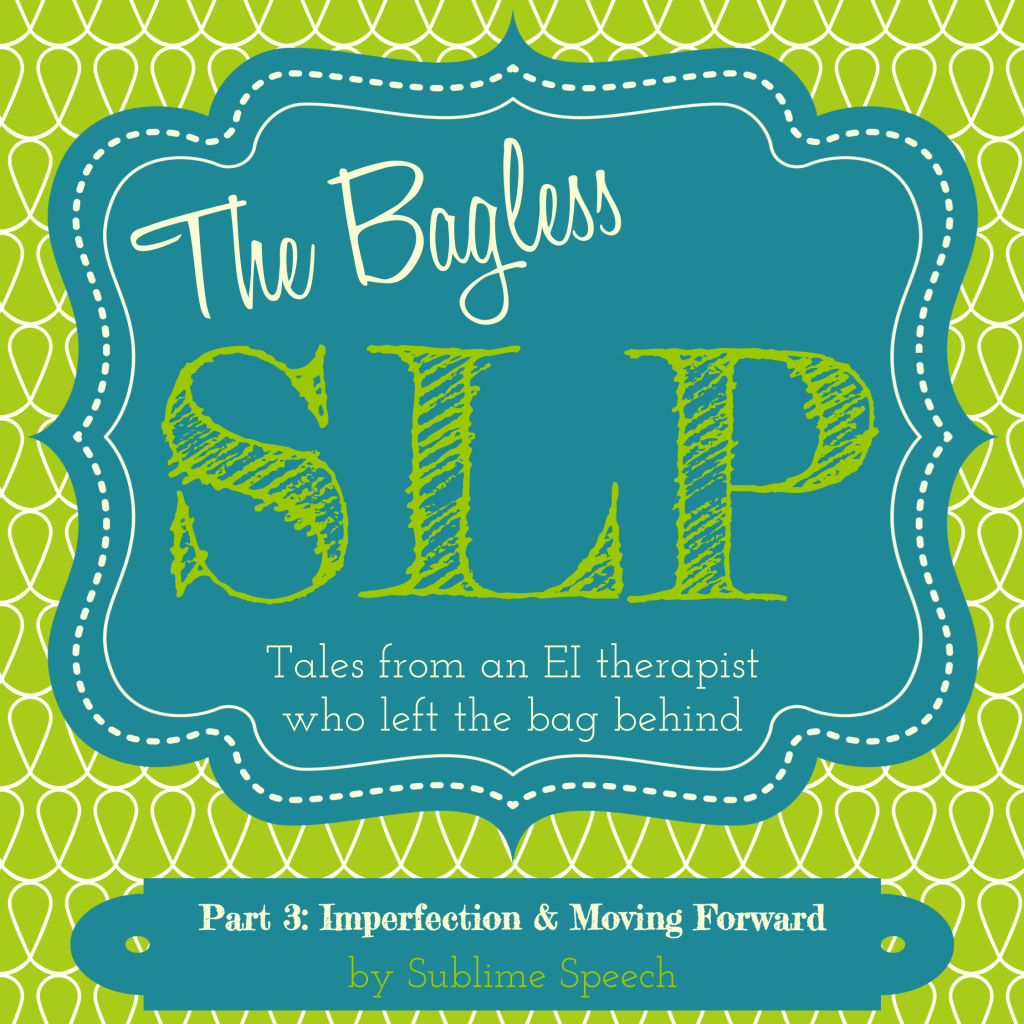 Welcome back! Or, if you’re just joining in on this series, head over to Part 1 & Part 2 to see what this Bagless SLP series is all about! In the last post, “The Good, the Bad, & the Unexpected”, I wrote about how it had been going… the good, the bad, and the unexpected! Today, about 2 months after going bagless, I’ll talk about the little imperfections of making the switch to bagless therapy and how I’ve moved forward. I’ll talk about what’s still in the trunk of my car, how families have reacted, and pieces that I’ve put into place to help moving forward!
Welcome back! Or, if you’re just joining in on this series, head over to Part 1 & Part 2 to see what this Bagless SLP series is all about! In the last post, “The Good, the Bad, & the Unexpected”, I wrote about how it had been going… the good, the bad, and the unexpected! Today, about 2 months after going bagless, I’ll talk about the little imperfections of making the switch to bagless therapy and how I’ve moved forward. I’ll talk about what’s still in the trunk of my car, how families have reacted, and pieces that I’ve put into place to help moving forward!
So, overall, going bagless has been great. I’m so excited to see how this transition continues to benefit my families and the children that I see. There has been less of a focus on me “playing” with the children and more about integrating techniques into daily routines. However, it has been far from a perfect transition. In all honesty, some of my families that I transitioned to bagless have had a difficult time with the adjustment. Here are some things in my transition to bagless that have not been “perfect” according to true bagless therapy:
- I still have a few toys/materials in my trunk. Now, as you can see below, there are FAR fewer toys and materials in my trunk. However, I allowed myself to keep one box-ish of toys including a few items:
- Bubbles (aka the “Session Saver”)
- Mr. Potato Head
- Wind-up toys and pull-back cars
- Interactive books
- Squigz
- Brown Bear slide book and other rotating books.
- Oral Motor tools
- Symbol communication book
- Cariboo (with First 100 Words to use)
- Kinetic Sand
- iPad
- Wipes
- Other rotating toys & puzzles if needed – rare!
- I’m just going to say it… Going bagless is more difficult than going in with a bag of goodies. Some days it’s harder than I’d like. Finding ways to implant language techniques in daily routines is not as comfortable to me as pulling out a great toy and imbedding language therapy into play with that item. Because it’s harder, it’s easy to slip back into the comfort of a bag full of toys. I’ve not been “perfect” in leaving toys behind completely.
- I’m still learning the best ways to counsel families and find routines to discuss. As much as I have learned about RBI and bagless EI services, I still sometimes have the feeling like I did during my first IEP meeting.
- Sometimes there is so much to address that it’s difficult to choose just one routine to start with.
- Yes, some of my families do not have many, if any, toys. If they do have toys, some of them have toys that are not very educational (a lot of cars, action figures, kids meal toys, etc.). It can be difficult to find ways that the families can interact with the child and their toys that can assist their language.
It hasn’t been perfect. It’s been pretty messy on some days. But for the most part, going bagless continues to be a great choice for my families. Despite being less than textbook perfection, here are the ways that I’m learning to overcome those imperfections and moving forward:
- I have tried to limit myself to bubbles and perhaps some wind-up toys or a book. On occasion, if a parent is receptive to purchasing toys for their child, I will introduce a toy that I removed from my trunk as a “trial” before they purchase. It allows me to show how to utilize a type of toy with their child. Otherwise, I do my best to reduce the number of items I bring in and utilize them only if necessary.
- I have allowed myself to make mistakes and learn from them. When something doesn’t go as well as I’d like in a session, I make it a priority to read more about the topic or find new resources to use or offer to the parents. I have learned from these “mistakes” of course!
- I have been developing and printing handouts for families. I have also started to leave “homework/session review” sheets with families to remind them of the week’s targets or techniques. It isn’t always followed through on but visual reminders help some families.
- I have trusted the families’ priorities more. I have followed their lead in selecting the routine that they would like help with or ideas for. Sometimes they need suggestions or options, but they can usually pick one from that.
- While I still love finding a great deal at thrift stores, I have begun to “lend” those materials to families if they are duplicates. I fully expect that the majority of these will not return in their original condition, if at all. But hearing “wow, look… it’s your FIRST BOOK!” come out of a mother’s mouth when I left behind an Eric Carle book behind that I found for $0.59 at Goodwill and watching the child toddle around clasping this book makes it 59 cents VERY WELL spent! And maybe, just maybe, that family will spend a little more time reading or talking about a great book with their child!
- Seeking training. I am hungry for more knowledge in this topic and am in the process of finding and enrolling in applicable training sessions! A huge part of being an SLP is continuing to learn. Sometimes it can be a burden to get 30 hours every 3 years for ASHA… but then again, it can be just the spark we need to continue to provide the best therapy possible!
So, after looking back at the past 2 months and this change that I’ve made would I say that it’s worth it? Of course! The research and my experiences allow me to be confident in continuing with my bagless therapy. As I continue forward, new clients will be approached entirely bagless. I will be able to fully implement this with them as they are acquired. I challenge you to do the same. It’s not easy but it’s research-based and worth it!
So… what questions or comments do you have about this topic?
Check out the previous posts in this series here:
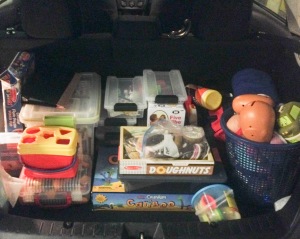
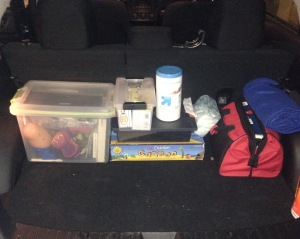
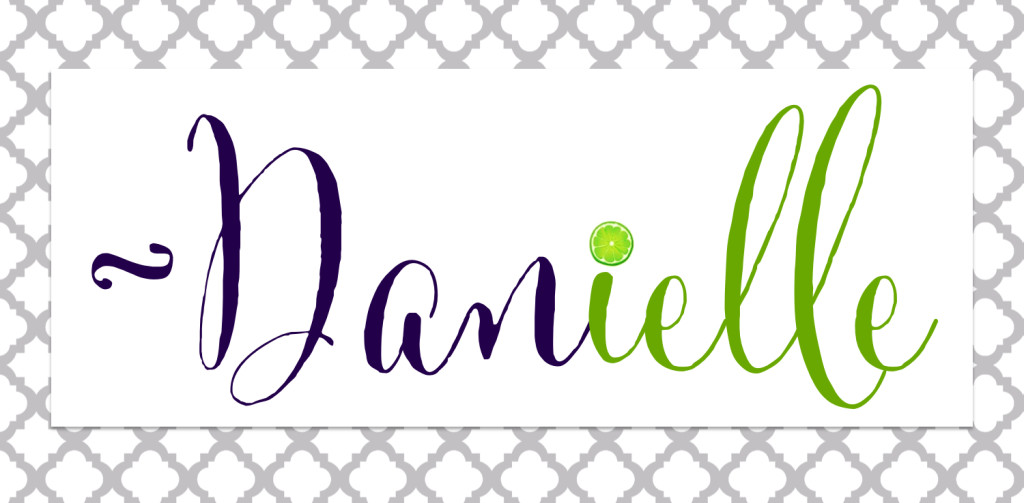
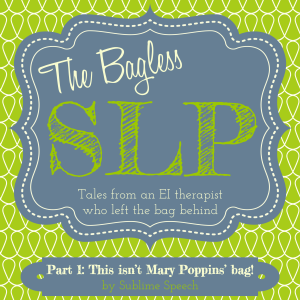
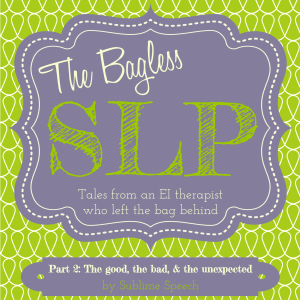
I love this series!! I know that when I worked in a lower income area school district, I had to think through my lessons and what was going to get the most bang for my buck in terms of teaching language. I found reading books and using the vocabulary from the book was one of the best tools as well as using the curriculum from the classroom. I know it is awkward without the bag, but in the long run, you are going to have tons of tricks to teach people with this type of therapy. I have often thought it would be so cool to start a book/toy loaning library for families.
I have found books, in great condition, as low as 15 cents (yes really) in Salvation Army and Goodwill stores so I would happily give or “lend” these to families. I am compensated fairly for my work, and love to give (without insulting any family, that can be delicate). Thanks for this series. I think it is important for professionals to also find ways to save (money, resources, waste, etc) and use natural environments as much as possible.
I have been making the same transition of going bagless. I find it much easier to do with very young kiddo’s or kiddo’s whose primary goals are in language. I am still feeling the need of my bag for my little ones who are closer to three and who primarily need help with ariticulation, phonology, apraxia etc.. Ideas?
I agree… if older and more artic/phono I tend to still bring in some activities like phono interactive books, apraxia app, etc. but attempt to bring things that I can leave or give a copy to the parents to use. My big focus with these clients is to find activities that can be taught and left or routines to imbed these techniques in. Otherwise, one hour per week will still leave little lasting impact. I find that the majority of my families can be taught to use simple cards or interactive books. Or I find children’s books with their sound and leave for the week. It all depends on the family/child though of course!
I love this! I’m a developmental specialist but work a lot on language with kids 0-3. We aren’t supposed to bring anything at all into homes now which was a huge switch because I too had the well organized trunk full of toys! Thank you for being honest about it being harder to do bagless therapy especially in homes without many toys. For years I would limit myself to 3 toys brought into a session rather than a big bag. I found that resulted in better attention from kids and less digging since kids could see all of their options up front but you’re right about the carryover. Right now I guess I’m ‘toy-lite’. I try to do the first session or few bagless to set the expectation that it is about family routines and participation not ‘therapy time’ but after that I’ll sometimes bring in a few things or leave a toy for a week or two for families to use.
I absolutely loved a presentation by Cari Ebert through Cross Country Education – The Power of Play. She is my favorite speaker ever because she gives real life examples and so many ideas throughout the presentation.
I love this series as well. I have recently made the transition form Public Schools to early intervention (I’m in a clinic but will also be going into homes soon). I have already scheduled one seminar on play therapy but I would like to know if you have been to any that interests you or which ones you were looking at. Also, do you have a template in your tPt for the forms you leave with the parents?
Again, I have loved reading this series! Thank you for your informative and thoughtful information.
Your posting is very timely for me. I’m an Occupational Therapist working in EI and challenged myself to go bagless late last year. It was so very liberating! No stuff to carry, no stuff to clean, no extra weight wearing the car out, cleaner car, no stuff to worry about attrition, no worries around Christmas that my car would be broken into for stealing the toys, kiddos that were pleased to share their toys, parents that were validated that the toys they had purchased were developmentally beneficial, kiddos and parents benefited by how the toys could be used differently than they had been doing, and more. Challenges were homes that all toys were in monster bins so it would take time to get enough parts together to make the toy useful, families that for what ever reason only buys stuffed animals as toys, all their toys have flashing lights and sounds, and many more. One of my parents begrudgingly went to get some toys out for play from the closet since most of play time was spent with the TV. It was the first time I’d seen that parent get off the couch. 🙂 We must have chatted for 10 minutes before she realized I was serious about not bringing in anything. I made the transition by using the valid excuse at the time that lots of my kiddos were getting sick November and December and I didn’t want to take any chances of accidentally sharing illnesses and all my parents were good with that. I enjoyed not having stuff but it made visits much more challenging for me. But then I found myself enjoying the increase in creativity I had to use to make a visit be productive. I have since slowly grown a little lazy and am now back at using the Bag because it is easier to work with a specific toy to get the skill that you are trying to promote. But I have to agree that my families were more engaged when using their stuff and not mine. So thank you for this timely series to get me back to being bagless. I have warned my OT FW II interns that we will be going bagless soon – starting their midterm. 🙂
Thanks for this series! I’ve read it twice – once to get me started and then when Indiana referenced it in their quarterly First Steps newsletter. I wonder if you would be willing to share some of the handouts you have developed for families? I searched your TPT store, but didn’t find any. Thanks!
A good way to transition to this would be to go into sessions with just a few toys to engage the kids with you. After they go through your 2-3 toys, then play with theirs.
I’m continuing to try and think of ways to get books to kids. On the one hand, the evidence indicates that using what the families already have/use is best for carryover. On the other hand, the evidence also indicates that it’s good to expose the kids to books, so I find it challenging when families have zero books.
In my grad school Hanen-type group (not actually Hanen but very similar), we created little books for the kids that they got to take home each week. I’ve thought about making some of my own. That way I know that the kid has at least one book – and it’s one that I approve! The problem is, I don’t really just want to make a paper book, or even a laminated paper one, because I feel like it won’t last long. But self-pubbing a board book might be hard. Hmm. We shall see!